The History brand appeared recently, in 2021, and so far very little is known about it. To date, we only know that the company’s large household appliances are assembled in Turkey, as well as in China and Thailand. Our today's hero is the History OE7710C.FBK electric oven, made in Turkey.
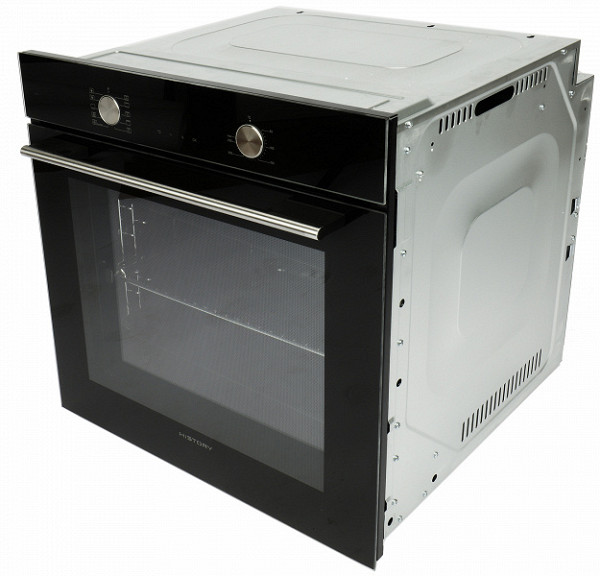
The History brand appeared recently, in 2021, and so far very little is known about it. To date, we only know that the company’s large household appliances are assembled in Turkey, as well as in China and Thailand. Our today's hero is the History OE7710C.FBK electric oven, made in Turkey.
Characteristics
| Manufacturer | History |
|---|---|
| Model | OE7710C.FBK |
| Type | built-in electric oven |
| Country of Origin | Türkiye |
| Guarantee | 24 months |
| Life time * | 10 years |
| Energy consumption | 3300 W, class A |
| Heating temperature | 50—275 °C |
| Volume | 77 l |
| Case color | black |
| Housing material | metal, glass |
| Inner coating | enamel |
| Door type | folding, removable |
| Number of glasses | 2 |
| Control | touch panel, recessed rotary switches and display |
| Number of operating modes | 10 |
| Cleaning type | hydrolytic |
| Oven guides | metal, removable, telescopic |
| Accessories included | metal grid, 2 baking trays of different depths and a FryArt baking tray |
| Functions | convection, grill, eco mode, defrost, timer, control panel lock |
| Weight without packaging | 30 kg |
| Dimensions without packaging (H×W×D) | 595×595×547 mm |
| Dimensions for installation (H×W×D) | 600×560×550 mm |
| Cable | 1500 mm long with F type fork |
* Contrary to popular belief, this is not the time limit after which the device will necessarily break down. However, after this period, the manufacturer ceases to bear any responsibility for its performance and has the right to refuse to repair it, even for a fee.
Equipment
The History OE7710C.FBK oven is supplied in a polystyrene foam box covered with durable polyethylene. The package contains a sticker with brief information about the model.
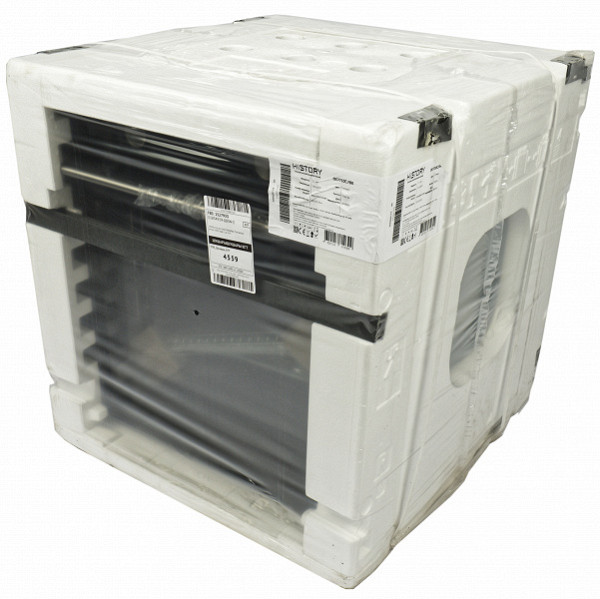
The package includes:
- oven with telescopic guides
- grill grate
- two baking trays of different depths
- FryArt baking tray
- instructions, user manual for FryArt baking tray
- energy efficiency sticker and warranty card
At first sight
The discreet, elegant design of the History OE7710C.FBK electric oven will allow it to easily fit into any modern interior.
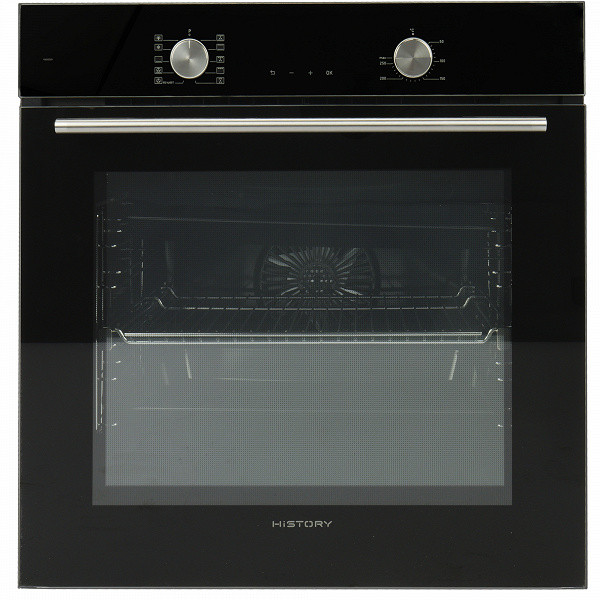
The facade of the device is made of glossy black glass, giving it a stylish look. The controls on the control panel and the double-glazed door have a sophisticated silver tone and matte finish. The door opens smoothly, silently and is held ajar. In addition, it and the glass are easily removable for easy cleaning and maintenance.
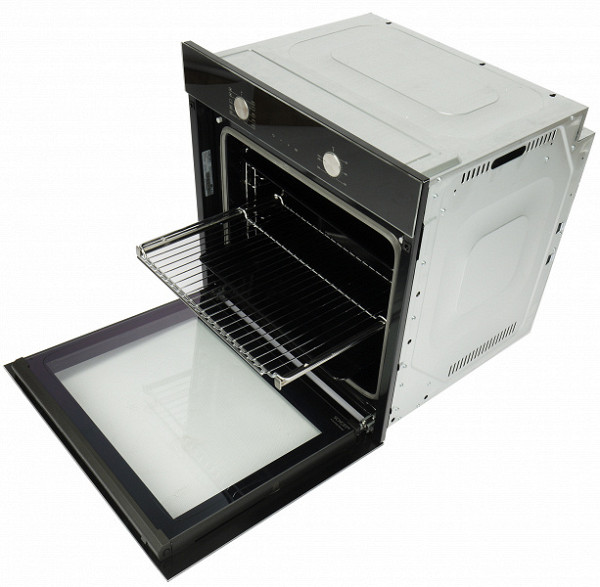
The interior of the spacious chamber with a capacity of 77 liters is covered with enamel. There is a grill heating element at the top, a convection fan with a ring heating element in the center of the back wall, and a 25 W light bulb installed in the top right corner. There are removable grates on the walls, allowing for baking trays to be placed on 6 levels.
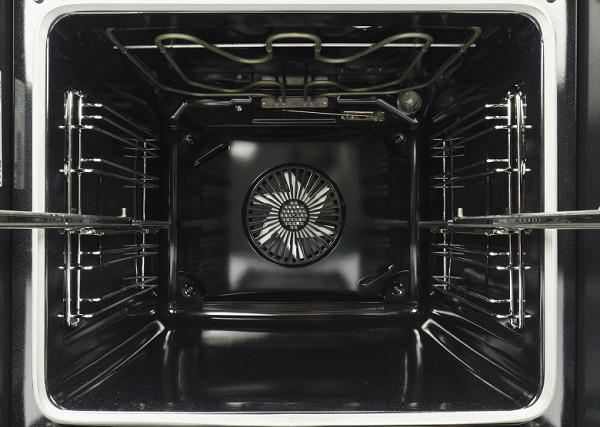
The grates are equipped with telescopic guides, which allow the hot pan to easily slide out of the chamber during cooking. These guides are removable and can be installed at any level for ease of use.
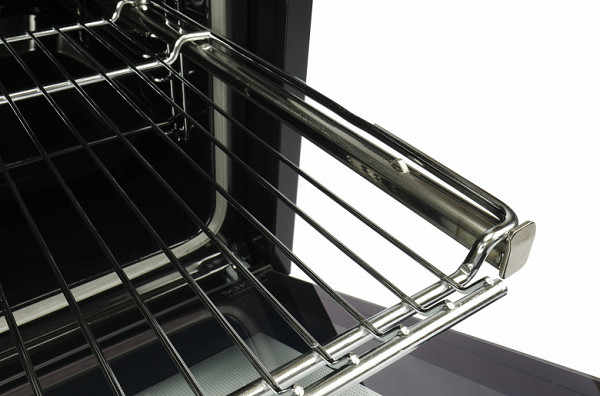
The outer side walls, like the back, are covered with metal panels with ventilation holes and stampings. There are also small slots on the sides for easy carrying.
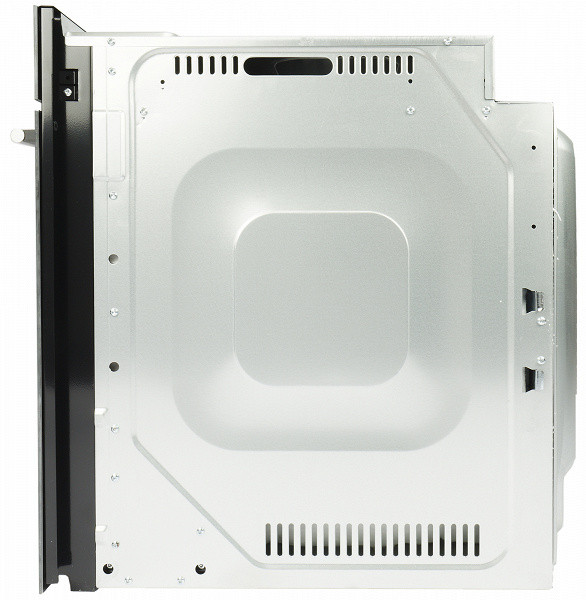
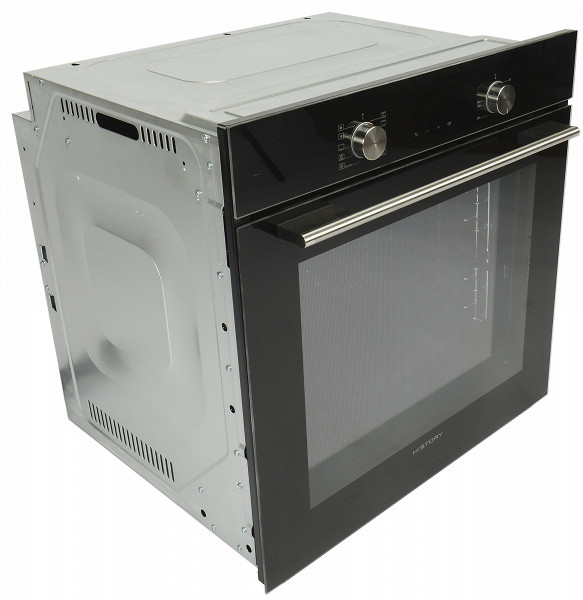
On the back wall, in addition to the ventilation holes, there is a place for attaching a 1.5 meter long power cord with a plug.
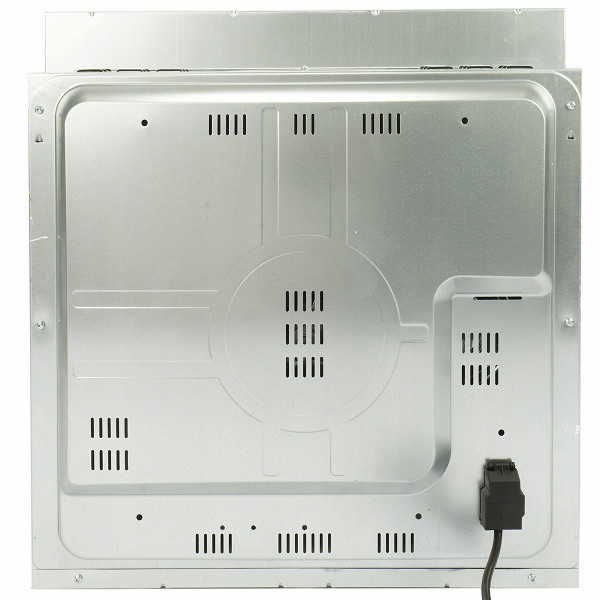
The oven kit includes: a standard metal grill,
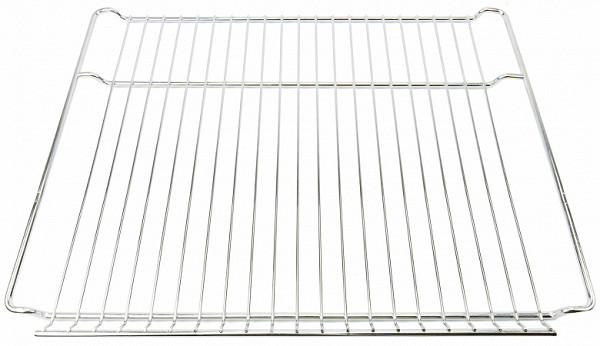
two baking trays of different depths
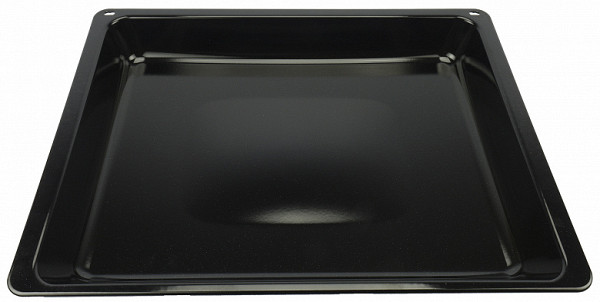
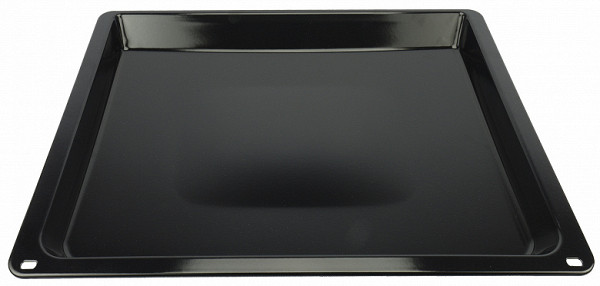
The FryArt pan features honeycomb holes and a perfectly smooth enamel finish like the other three accessories. For best results when using the FryArt pan, it is recommended to place food on the pan without foil or parchment to allow free circulation of hot air. To prevent sticking, just lightly grease the surface with vegetable oil. It is recommended to place an empty tray on the lower level to catch any drips or crumbs.

The assembly of the device is carried out carefully, and the materials used in the manufacture of all elements seem to be of high quality. The first impression from our visual inspection of the oven left us with a positive impression.
Instructions
History OE7710C.FBK includes: instruction manual, separate FryArt pan instructions, installation guide and energy efficiency label.
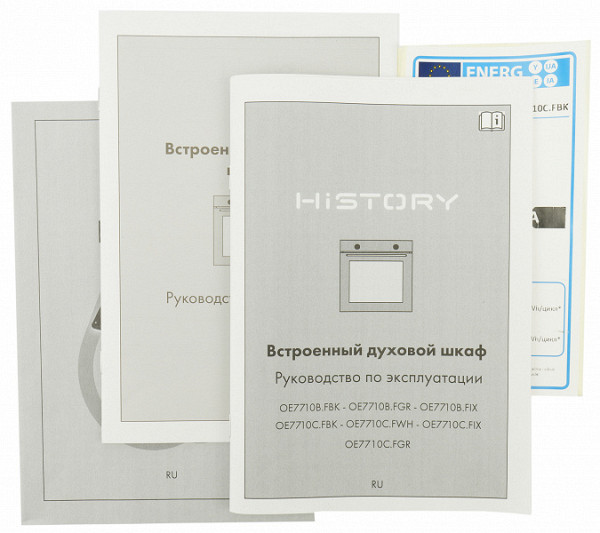
The basic instructions provide all the necessary information for daily use. It includes chapters on the structure of the oven, a detailed description of the controls and cooking modes, safety precautions and care rules. The last pages contain the warranty card.
The additional FryArt Tray Operating Brochure contains useful information about this accessory, as well as a table with recommendations for selecting modes and cooking times on this baking sheet.
Control
The History OE7710C.FBK control is located at the top of the front panel and includes two recessed knobs for selecting modes and adjusting the temperature, as well as four touch buttons for decreasing and increasing the specified parameters, confirming a selection and canceling an operation.

Above the buttons there is a display with a timer, which, when the oven is on, shows the remaining cooking time, and when the oven is off, goes into clock mode.

Using the timer and buttons, you can set the operating time of the device, configure the delayed start function and set the current time on the clock. However, if there is a power outage, the clock is reset, and after power is restored, it shows the “zeroed” time. Without setting the clock, the oven will not start.
In addition, in addition to setting the clock and timer, you can change the alarm melody or turn off the sound completely, as well as adjust the brightness of the display backlight.
The right rotary control is used to select the heating temperature from 50 to 250 °C or up to the maximum value. The scale of divisions on the regulator is convenient; each division corresponds to 10 °C.
The left knob is responsible for selecting operating modes:
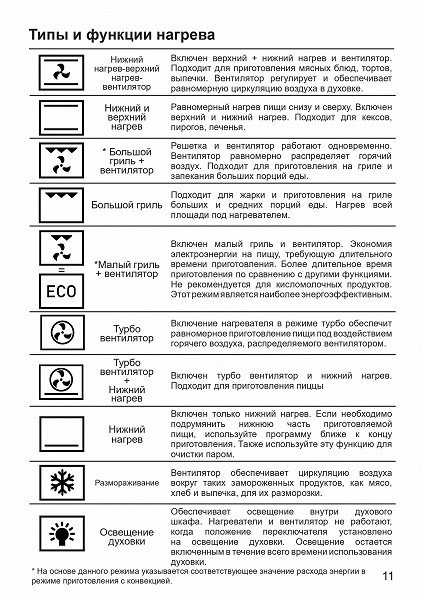
The controls are intuitive and do not cause any difficulties.

After setting the temperature and selecting the mode, the oven begins to heat up, which is indicated by the red indicator on the left side of the panel lighting up. When the set temperature is reached, the indicator stops lighting. At the end of the program a beep sounds.
Exploitation
First, we preheated the oven to 200 °C in the top + bottom mode for one and a half hours, as recommended in the instructions. The slight technical smell disappeared within the first 10 minutes. We then wiped down the inner chamber, washed the baking trays with wire racks and dried them.
I would like to note the excellent performance of convection, thanks to which all products are cooked evenly, even if they are on several levels. The uniform distribution of heat over the surface of the baking sheet was also a pleasant surprise.
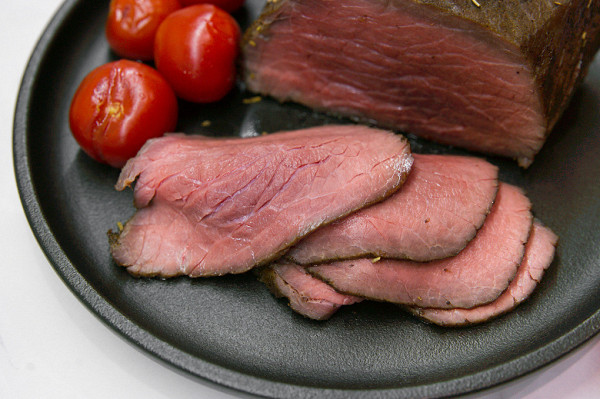
In convection modes, the oven increases the temperature by about 20°C, so if you want to reach 180°C, you should set it to 160°C. You can be sure that the temperature will be maintained very precisely throughout the entire cooking cycle.
The divisions around the temperature regulator are conveniently designed, allowing you to adjust the temperature in 10 °C steps. The «Max» value, according to our measurements with a pyrometer, corresponds to approximately 285 °C.
In addition, it should be noted that the cabinet chamber has excellent thermal insulation. The high temperature is maintained inside the chamber for a long time, which allows you to save electricity by continuing to cook in an already cooling oven.
Care
After each use, clean the cooled oven cavity, glass door, baking tray and rack using an absorbent kitchen towel or a soft sponge with a neutral detergent. It is important to avoid using scratching or abrasive materials.
For severe contamination, steam cleaning is recommended. To do this, place a deep baking tray with a small amount of water on the lowest level and turn on the lower heating mode at a temperature of 100 °C for 20 minutes. At the end of the procedure, wipe the inside of the oven with a damp cloth or sponge.
Our measurements
In standby mode, the device consumes 0.6 W.
The maximum energy consumption in the top and bottom heating mode at a temperature of 200 °C was 2166 W, and in the top and bottom heating mode with convection at a temperature of 180 °C — 2329 W.
For 1 hour of operation in top and bottom heating mode at 200 °C, the oven consumed 1.584 kWh, and in top and bottom heating mode with convection at 180 °C — 1.371 kWh.
A cold oven heats up to 200°C in 17 minutes.
We checked whether the heating of the baking tray corresponded to the set temperature and the spread of values over its surface. Having set the temperature to 180 °C and turned on the convection mode with top and bottom heating, we placed the temperature probe on the baking sheet. Maintaining heat in the oven occurred as follows: first, the temperature rose to a certain limit, then it began to fall (the heating was turned off), and it began to rise again (the heating was turned on). We recorded the minimum and maximum temperature values at five points on a heated baking sheet.
| 191—198 °C | 190—197 °C | |
| 195—204 °C | ||
| 191—201 °C | 189—194 °C |
The noise produced by the oven during operation is moderate; without a fan it is not audible at all. Heating of the case is quite comfortable: the oven door, operating at 200 °C with convection for an hour, heated up to a maximum of 50-55 °C, the sides — up to 25 degrees, and the outer top panel — up to 27 °C.
Practice tests
Roast beef
For the first test, we chose a piece of beef loin weighing about one and a half kilograms. The meat was brushed with olive oil, then rubbed with a mixture of salt, dried rosemary and thyme, and generously sprinkled with black pepper. After this, coarsely chopped garlic was evenly distributed over the surface of the piece of meat. We then wrapped the whole thing in foil and left it at room temperature for about an hour.
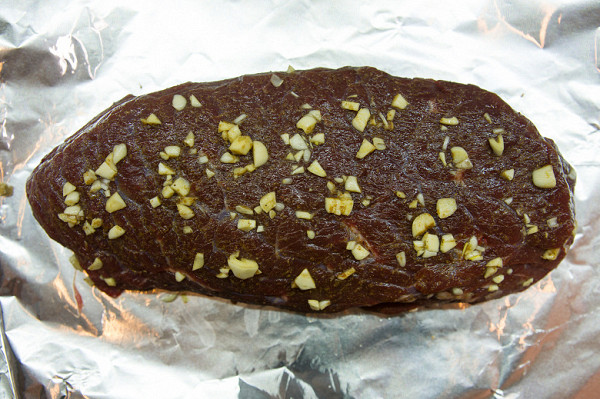
Later we opened the package and peeled the garlic from the meat. Instead of throwing it away, we saved it to use later when baking. We then heated the grill to maximum heat and quickly seared the meat on all six sides to achieve the Maillard reaction — the transformation of amino acids and sugar into caramel under high heat, giving the food its distinctive taste, characteristic smell and delicious crust.
Meanwhile, the oven was preheated to 160 °C in the upper and lower heating mode with convection. We took into account the possibility of overheating when turning on the fan, so to achieve 160 °C we set the regulator to 140 °C. We did the same in other tests where convection was used.
The meat was placed in a baking dish on a bed of remaining garlic from the marinade. To accurately control the temperature inside the piece, we inserted the probe tip so that its end was in the very center of the meat and set the temperature to 50 °C. When placed in the oven, the internal temperature of the meat was 30 °C.
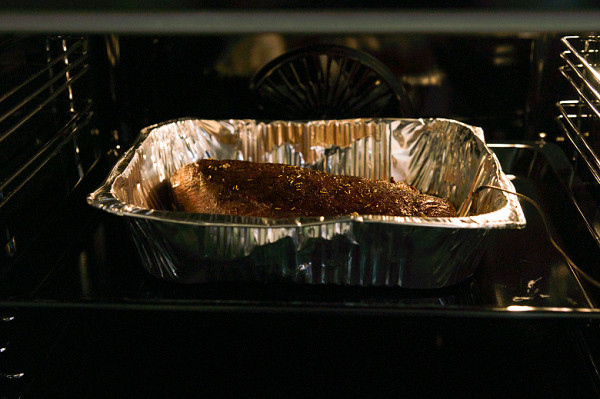
We did not cover the pan, but turned the meat halfway through the process to ensure even baking. As soon as the temperature probe beeped, we took out the pan, covered it with foil and left it on the table so that the meat could rest.
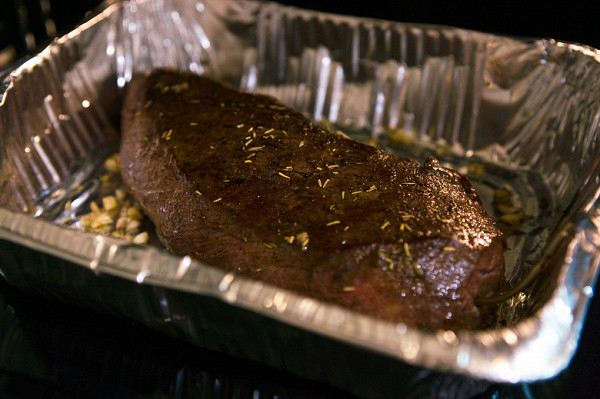
The temperature inside reached 58°C within 10 minutes and stopped. The result is excellent: the meat is very tender and juicy. It becomes even tastier when cold.
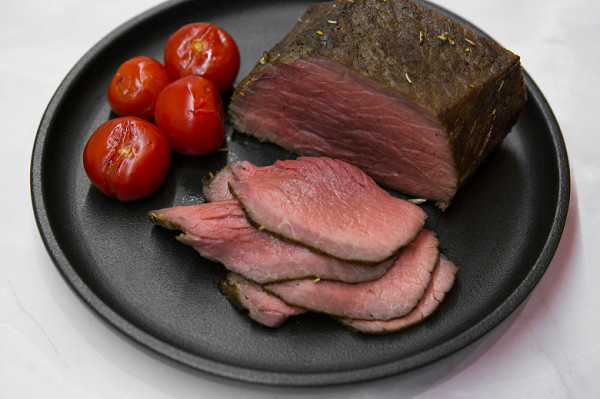
Result: excellent
Eggplant, garlic and carrots in honey glaze
The eggplants were cut into large slices, then they were pressed in cold salted water. After half an hour, we washed and squeezed out excess moisture, and then mixed them with coarse salt and a little oil.

Chopped carrots were mixed with salt, spices and chopped garlic. Three heads of garlic were peeled and the tops cut off. The cut was sprinkled with oil and sprinkled with salt.

Place a pre-greased Fryart tray with carrots on the baking sheet with the eggplants and garlic and place them on the same level, covering with foil.
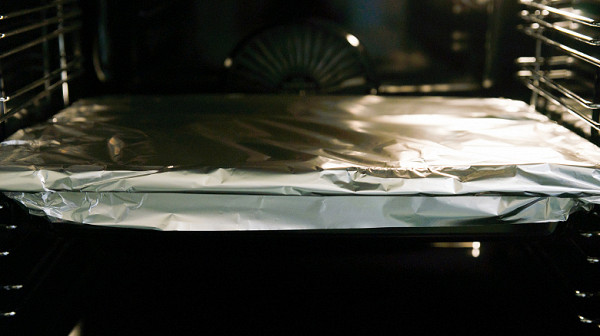
For the first 30 minutes, the oven operated in top+bottom mode with convection at a temperature of 200 °C.
While the vegetables were roasting, we prepared honey with nutmeg and cinnamon. After 30 minutes, we took out the tray of carrots, dipped each piece in the honey mixture and returned it to the baking sheet. The foil was removed and the eggplants were moved to a lower level. We then switched the setting to high grill and kept the vegetables in the oven for about 20 more minutes.
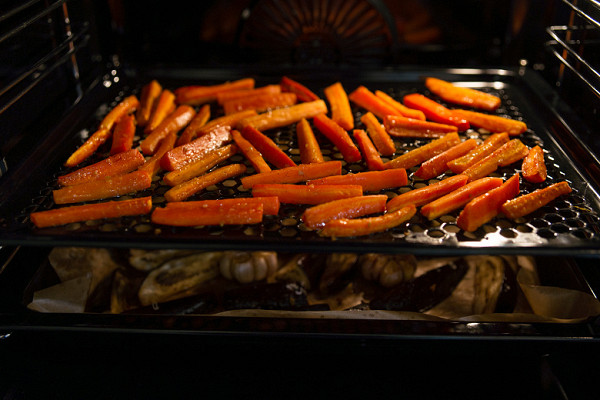
Baking was even at all levels, and the grill sealed the glaze well. We did not find any burnt or raw pieces.

Result: excellent
Baked sea bass
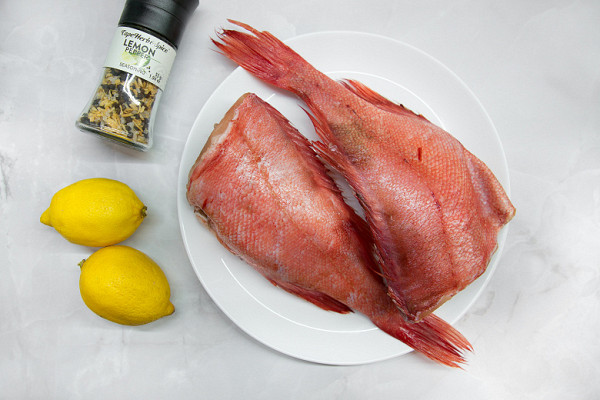
The fish were cleaned of scales, the sharp fins were trimmed with scissors and the tails were removed. Each carcass was cut on both sides. Then the fish was rubbed with spices, salt and lemon juice outside and inside, placed on foil and placed on a perforated baking sheet.
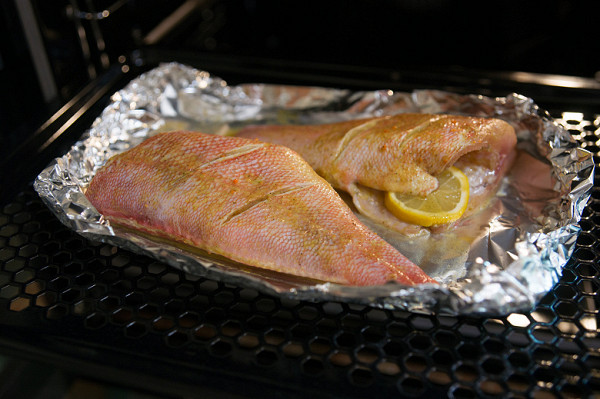
After 15 minutes, cherry tomatoes were added to the fish.
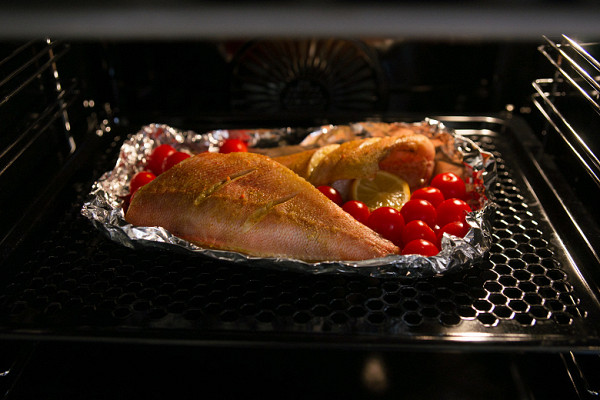
At 200 °C on FryArt, it took 30 minutes to bake.

During the cooking process, we did not turn the fish over, but thanks to the perforations in the pan, this did not prevent the skin from underneath from being well baked and not stewed. Despite the fact that the layer of foil prevented proper airflow, the fish was cooked perfectly.
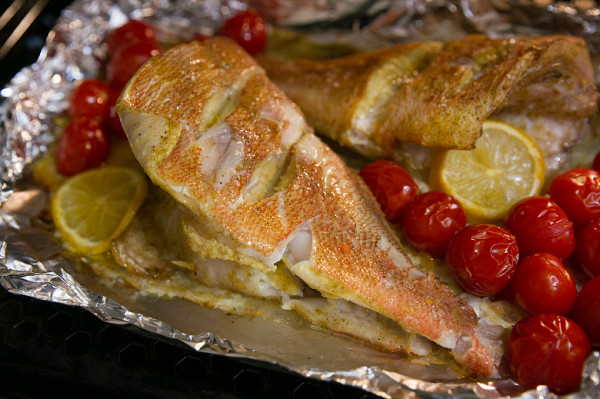
Just like that, we ended up with an incredibly delicious dinner.
Result: excellent
Potatoes and chicken legs
The larger potatoes were cut into two or four pieces, while the smaller potatoes were left whole. Then they were sprinkled with spices and salt, vegetable oil was added and everything was thoroughly mixed. Chicken legs were marinated in sour cream with dry garlic, salt and ground pepper for an hour.
The oven was preheated to 180 °C in top + bottom mode with convection. 1.5 kg of potatoes were placed on the bottom baking sheet.
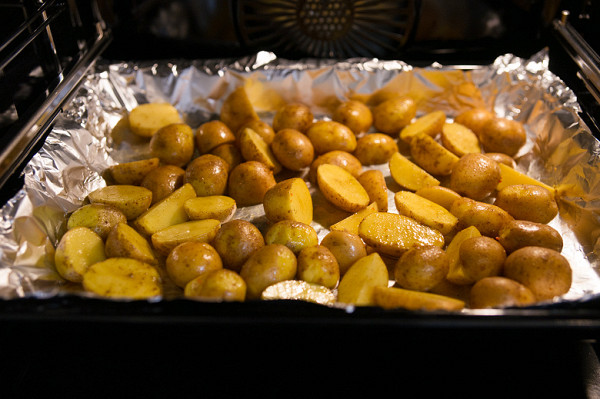
Two containers with chicken were placed on the grill above.
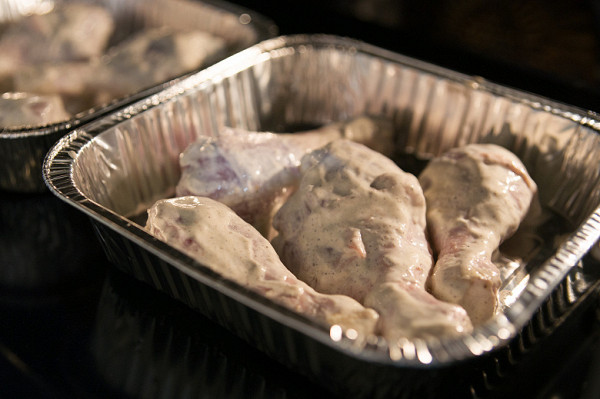
We only had to stir the potatoes once — they browned more on the bottom. This happened not only because the top layer of potatoes was covered with chicken, which absorbed the main flow of heat, but also because, as it turned out from the documentation, the lower heating element was 100 W more powerful than the upper one, which we verified at practice.

The chicken was baked evenly, but in the end we still changed the mode to the upper grill with convection for a more golden brown crust. As you can see from the photo below, we succeeded.
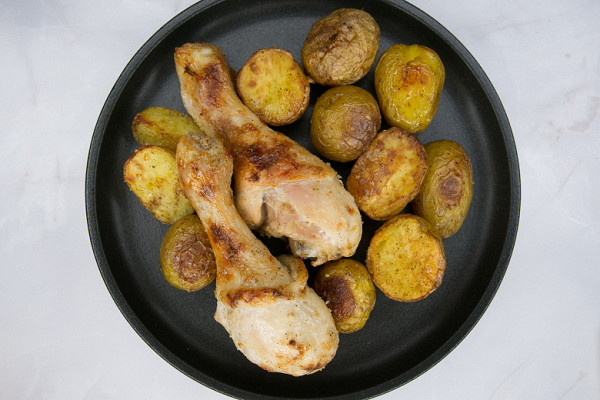
Result: excellent
Gingerbread cupcake
Ingredients: 250 g rice flour, 60 g sugar, 1 tsp. baking powder, 90 g butter, 50 ml milk, 2 eggs, 10 g mixture of cinnamon, cardamom, nutmeg and ginger, a pinch of salt.
In a separate container, mix sifted flour, baking powder, salt and a mixture of cinnamon, cardamom, nutmeg and ginger. Beat softened butter with sugar. Gradually adding eggs, achieved an airy mass, poured in milk, added all dry ingredients and mixed well. The dough turned out glossy, thick and viscous. The oven in the top+bottom mode has by this time warmed up to 160°C.

We poured the dough into the mold, placed it on the wire rack, closed the door and began to observe the cooking process, fortunately the sufficient transparency of the window facilitates this. After 40 minutes, focusing on the appearance of the product, we turned off the oven and took out the container.
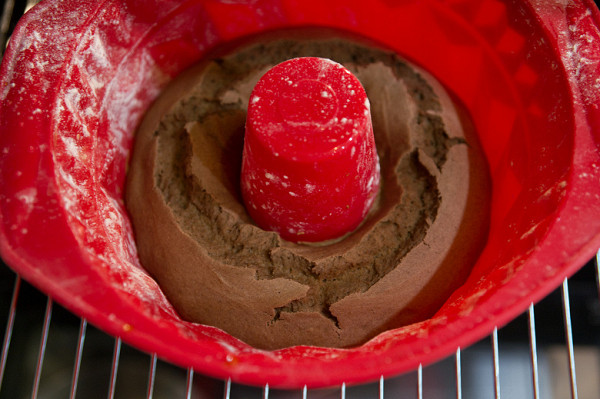
The cake was not burnt on either side, the crust on top and bottom was the same in degree of browning, and the dough inside was baked evenly.
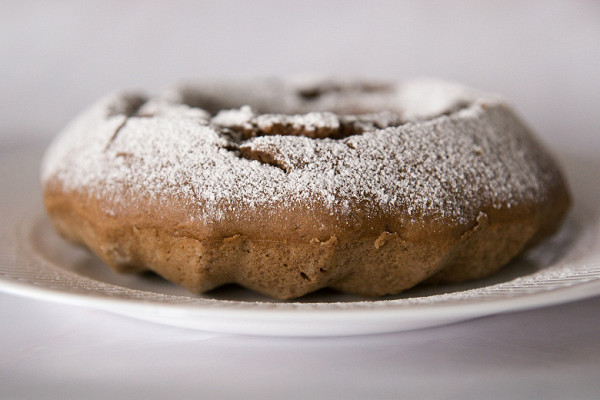
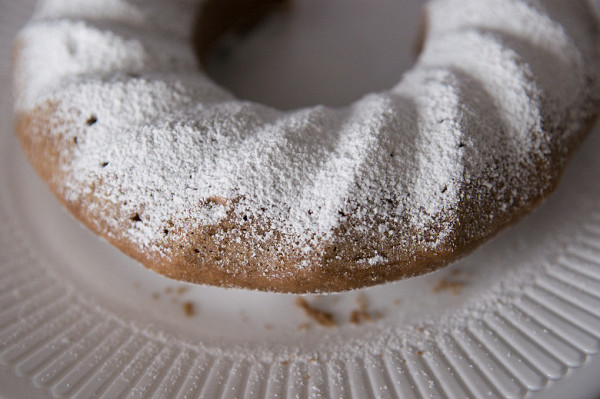
The cake tasted very similar to soft gingerbread.
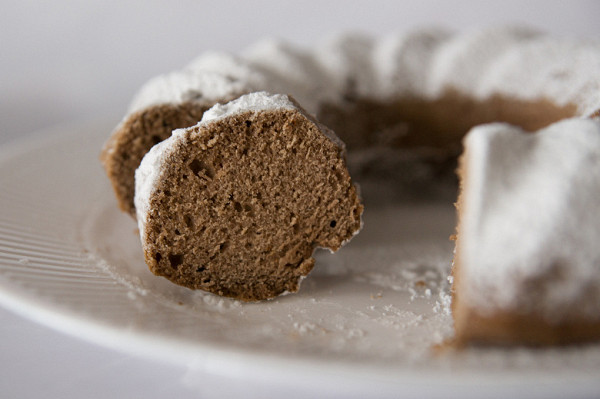
Result: excellent
conclusions
The History OE7710C.FBK oven can be integrated into any available space in the kitchen that matches its size. Its stylish and minimalist design makes it easy to fit into any modern interior. The device copes well with preparing various dishes, and during our use we did not encounter any problems.

Among the main advantages, it is worth highlighting uniform and stable heating throughout the entire cooking process. This eliminates the risk of burning or undercooking food. The only thing you should pay attention to is a slight increase in temperature when operating in convection modes. In addition, the device comes with good equipment, including convenient baking trays and racks made of quality materials, and is also easy to clean thanks to a large number of removable housing elements.
Pros:
- convenient control with timer
- recessed handles and soft-closing door system
- a lot of modes with different combinations of heating elements
- uniform heating and maintaining temperature throughout the cooking time
- removable door, glass, side grilles and telescopic guides, adjustable to any level
Minuses:
- no blocking of the control panel from accidental touches


